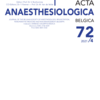The effect of digital nerve block on the accuracy of hemoglobin monitoring during surgery: A randomized clinical trial
blood transfusion; hemoglobin, spectro-photometry; accuracy; digital nerve block; bupivacaine
Published online: Mar 29 2022
Abstract
Background: The decision to transfuse blood products to patients during surgery is critical, due to the potential complications and costs of transfusion. Measuring hemoglobin level by spectrophotometry (SpHb) plays an important role in making this decision. The accuracy of SpHb depends on the finger perfusion. Since digital nerve blocks (DNB) can enhance blood circulation, we aimed at investigating DNB effects on the accuracy of SpHb.
Methods: Patients undergoing spine surgery were randomly assigned to two groups. Group A received DNB in the left hand, and group B received DNB in the right hand. In each group, the other hand was considered as the control. Rainbow adult ReSposable sensors were attached to the patients’ both hands. Before surgical incision and every 1.5 hours, the SpHb values of both hands and the perfusion index were recorded. Concomitantly, arterial blood samples were drawn and sent to the lab for hemoglobin concentration measurement. This served as the gold standard for assessing hemoglobin levels (labHb). We used a mixed-effects generalized linear model to test the effect of independent variables on the difference between SpHb and labHb at each time point.
Results: The SpHb displayed higher hemoglobin levels than those assessed by the lab. For lower labHb values, the SpHb-labHb differences were larger. A one-unit decrease in labHb increased the difference between SpHb and labHb by 0.56 g dL -1 , which was statistically significant.
DNB significantly increased the difference between SpHb and labHb by 0.42 g dL -1 . The effect of DNB on the difference between SpHb and labHb was significant up to three hours after the beginning of surgery (0.58 g dL -1 difference between blocked and non-blocked hands).
Conclusion: This study shows that, when hemoglobin levels are low, the accuracy of spectrophotometry decreases. Although DNB increases finger perfusion, it leads to an overestimation of hemoglobin levels by SpHb.
